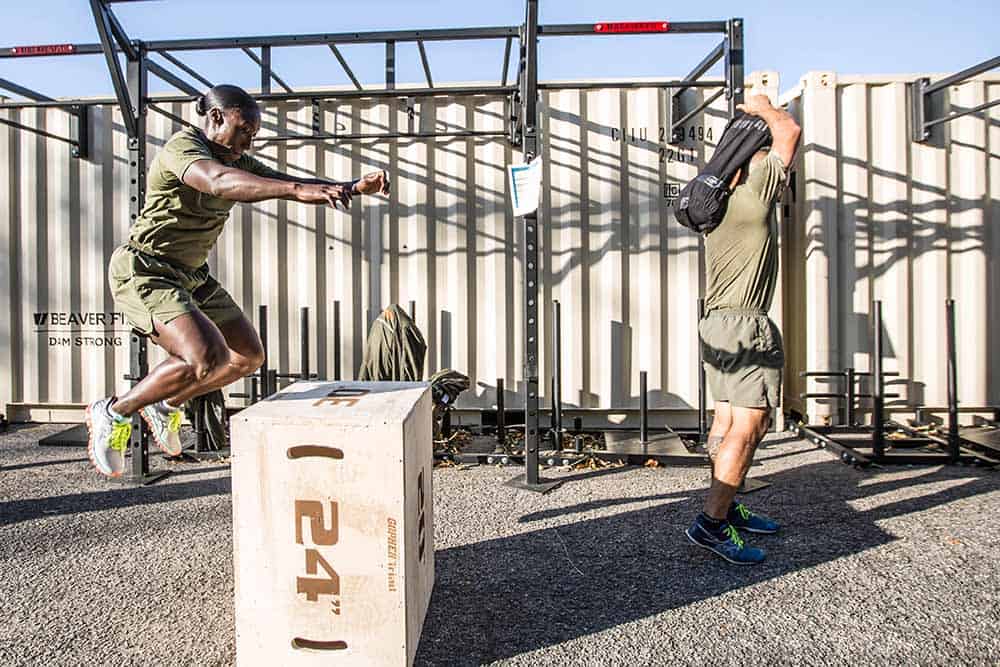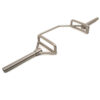Fitness
Introduction to Plyometrics
What is plyometrics?
Plyometrics (or simply plyos) is a type of exercise that aims to improve power (the combination of strength and speed).
Plyometrics is an excellent training method for increasing ‘explosive strength’.
Plyometrics is sometimes called jump training. However, it should be noted that plyometrics is not restricted to only jumping-based exercises, even though they are the most common type of plyometrics exercises.
Stretch-shortening concept
A concentric contraction performed immediately after an eccentric contraction can produce greater force than a concentric contraction performed alone. This concept is known as the stretch-shortening cycle (SSC) and is fundamental to plyometrics.
The first stage of the SSC (the eccentric contraction) is often referred to as the ‘pre-stretch’ or ‘countermovement’ action. For example, when preparing to jump, we instinctively hinge at the hips and bend our knees to drop ourselves down before springing up.
To take full advantage of this elastic energy, the concentric contraction must occur almost immediately after the eccentric contraction.
For example, when performing a jump squat:
- the participant starts the exercise by squatting down from a standing position (eccentric contraction of the quadriceps femoris group of muscles);
- they then jump explosively out of the squat position (concentric contraction of the quadriceps);
- after landing from the jump the participant squats down immediately to perform the next repetition; and
- so on until they complete their set.
Elastic energy
The elastic energy which forms the foundation of plyometrics comes from the elasticity of the musculotendinous unit, which comprises muscle fibres, muscle membranes and tendons.
Elasticity refers to the ability of muscles and tendons to return to their normal length after being stretched.
Tendons are connective tissues or ‘bands’ connecting muscle to bone. The elasticity of these bands, known as the series elastic component (SEC), is widely agreed to be the primary source of elastic energy used in plyometrics.
The elastic energy of muscle membranes is referred to as the parallel elastic component (PEC).
The contractile component is the muscle fibres, which work in parallel with the elastic muscle membranes and in series with tendons (another elastic component) to produce the elastic energy.
Stretch reflex
Muscles and tendons contain sensory receptors, referred to as ‘proprioceptors’. These proprioceptors send signals to the central nervous system about changes in the length of muscles and tendons.
When a musculotendinous unit is lengthened, a ‘stretch reflex’ response is triggered in order to prevent over-lengthening (i.e. injury). This results in a reflexive muscle contraction to control the length of the musculotendinous unit.
Plyometrics aims to take advantage of this reflexive contraction.
Examples of plyometrics exercises
Here are just a few examples of common plyometrics exercises:
- box jumps;
- depth jumps;
- jump squats; and
- plyometric push-ups (often called a plyo push-up).
Plyometrics equipment
For high quality plyometrics equipment, we recommend Iron Edge. Make sure you use our exclusive discount code (IE-616) for 5% off your purchase at Iron Edge.
Popular equipment for plyometrics training
- Plyometric boxes (often called plyo boxes)
- available from Iron Edge here (use our 5% off coupon: IE-616).
- Hurdles
- Medicine balls (weighted balls)
- available from Iron Edge here (use our 5% off coupon: IE-616).
We highly recommend using padded boxes and hurdles, as this greatly reduces the potential risk and severity of injury.
Who would benefit from plyometrics training?
Anyone that wishes to increase their explosive strength could benefit from incorporating some plyometrics training.
However, given the higher impact on joints and tendons, it is particularly important that participants use correct exercise technique.
Given the explosive nature of plyometrics exercises, beginners should only participate in plyometrics training under the supervision of a qualified instructor.
Training for athletes
Plyometrics training is particularly beneficial for athletes that require explosive strength (the combination of strength and speed), in sports such as:
- basketball;
- rugby;
- tennis; and
- volleyball.
For example, an athlete that plays basketball could use plyometrics training to help improve their vertical jump.
Safety considerations
Plyometrics poses a higher risk than many other training methods.
To ensure the health and safety of participants, the following guidelines should be considered before undertaking plyometrics training.
- Plyometrics should not be done in a fatigued state. For example, it should not be programmed for the end of a fitness session.
- The training area must be free of any hazards, such as hard objects that a participant might collide with or fall on. We highly recommend using padded boxes or hurdles.
- Participants must have sufficient strength, balance, mobility (e.g. dorsiflexion and plantarflexion of the ankle) and capability to safely perform the exercises. Plyometrics training is not usually suitable for new or novice fitness participants.
- Measures that are often used as the baseline for determining if a participant has sufficient strength to commence plyometrics are:
- for lower body plyometrics, being able to squat 1.5 times their own bodyweight; and
- for upper body plyometrics, being able to bench press the equivalent of their own body weight.
- Measures that are often used as the baseline for determining if a participant has sufficient balance are:
- being able to stand on one leg for 30 seconds; and
- for advanced plyometrics exercises, being able to perform and hold a single leg half squat for 30 seconds. ‘Half squat’ simply means squatting to a reduced depth, with the participant descending to a point about halfway between thighs parallel to the ground and fully standing.
- Heavier individuals will face greater impacts (stress) on their joints and tendons; and so may need to consider exercise modifications. For example, as a general rule, for participants that weigh more than 100kg, the box height for box jumps or depth jumps should be 46cm or less.
- The landing surface should be flat, stable (e.g. not a trampoline), non-slip and preferably not unforgivingly hard (e.g. not concrete). The dense rubber matting used as flooring in most fitness facilities is ideal.
- The ceiling height must allow plenty of clearance for safely performing any jumping movements.
- The participant’s shoes should be grippy, wide enough for a solid base, well-cushioned and provide ankle support.
Article image credit: Sgt. Melissa Marnell, United States Marine Corps.











